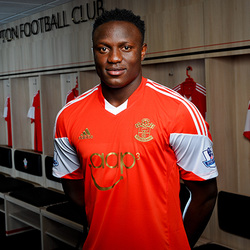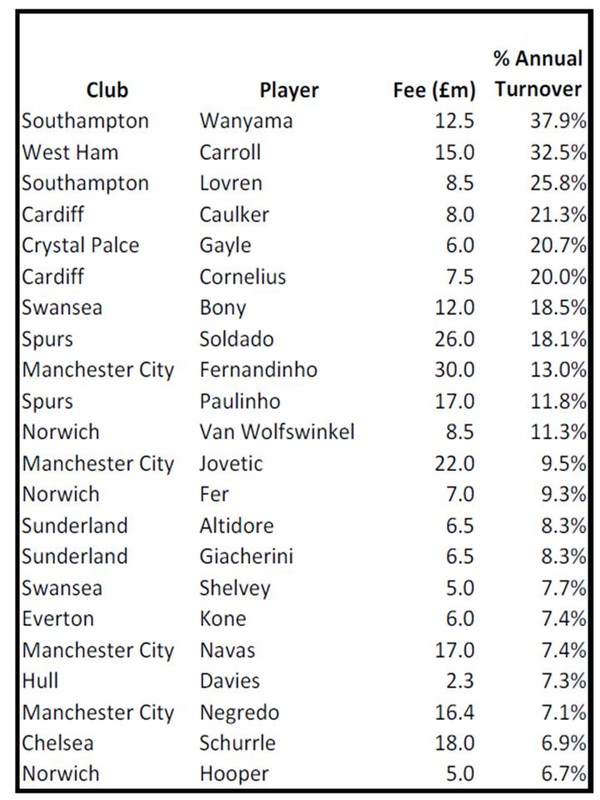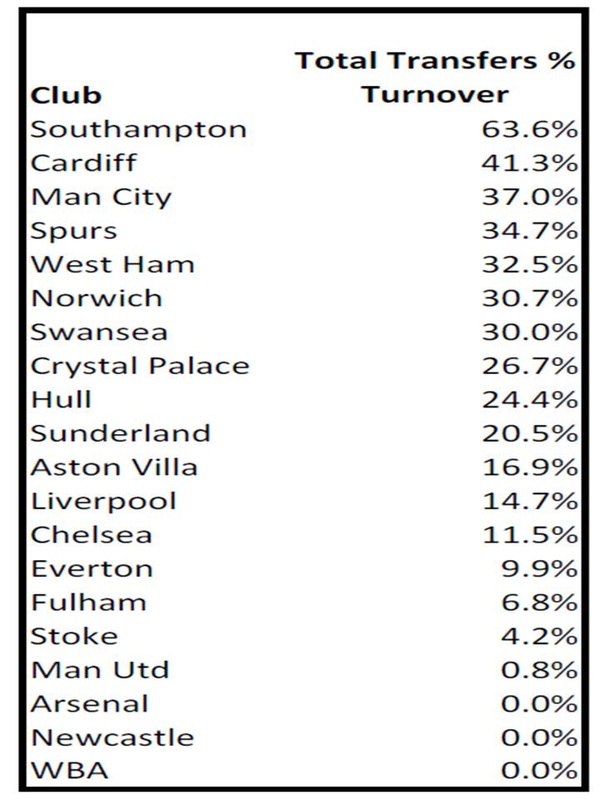
But when I hear these large numbers thrown around I'm reminded of an old joke about an economist walking down the street who was asked by an old acquaintance how his mother was, to which the economist replied "Relative to what?". While Real Madrid may spend £80m on Gareth Bale and Manchester United may spend £35m on Cesc Fabregas, is this really a lot of money for these clubs? And is there a way to compare the profligacy of clubs in the transfer market?
It is very common in economics to control for size effects, for example to compare the wealth of countries we use Gross Domestic Product (GDP) per capita or to measure productivity we use GDP per worker. This allows comparison between different countries of different size. It should also be the case that transfer fees should be controlled for a variable that allows comparison between clubs. All transfers involve risk but an £80m punt on Bale may be less of a risk for Real Madrid than an £80,000 punt by a League of Ireland club.
So, if we control for size of a club, using annual turnover, which Premier League teams have been most profligate this summer and who have been the big signings? First of all the limitations in the data have to recognised. It isn't easy to get turnover data for football clubs - this is a usual source. Turnover for 2012 is the most recent. Also, there is no data for the newly promoted clubs. These clubs are about to experience a significant increase in turnover from promotion. Comparing turnover for previous years for promoted clubs, it is likely that these clubs will experience an increase of about £20m. This has been added to 2012 turnover for newly promoted Crystal Palace, Hull City and Cardiff City.
The other complication is the reliability of the transfer fee. I am using this list of summer transfers with reported transfer fees - it seems as good as any and since I am concerned with comparing fees rather than the nominal amount a systemic understatement or overstatement shouldn't be a problem.
| So, while the largest transfer fee recorded this summer, so far(!), was Man City's £30m for Fernandinho with Soldado to Spurs for £26m also getting a lot of attention, it was not the "biggest" transfer when we control for the size of the clubs. Southampton's £12.5m purchase of Victor Wanyama from Celtic accounted for just under 40% of their annual turnover. Quite a risk for a club to take on one player. What's more they also spent a quarter of their annual turnover on Dejan Lovren from Lyon. West Ham have also spent big (relative to their income) on making Andy Carroll's loan move permanent. We need some caution on the spending by newly promoted clubs as we know they have increased income this year but it is unclear now just how much extra. These clubs are in a difficult position of deciding whether to spend to try to survive in the Premier League or be more cautious in case they drop back down again with expensive players on their wage rolls. Perhaps Cardiff's 'big' signing of Stephen Caulker was helped by the wealth of their owner relative to other clubs, as David Butler pointed out here. |
| It's also possible to look at which clubs are most profligate and based on the previous table it's hardly surprising that Southampton lead the way. Man City feature more prominently here as they have spent large sums on several players (Fernandinho, Jovetic and Navas). There is likely to be change before the transfer window closes. Especially if Man Utd land Fabregas (though at £35m he would come in as the 12th "biggest signing" after Van Wolfswinkel of Norwich). Also, Arsenal purchase of Suarez would move them up significantly - a purchase fee of £40m would put him in as ninth after Spurs' Soldado. Of course turnover is less important when there is a billionaire available to fund marquee signings and, while the Financial Fair Play rules will make this a more relevant exercise, it is likely that there are too many loopholes in those rules to stop clubs splashing the cash for a shot at glory. |


 RSS Feed
RSS Feed